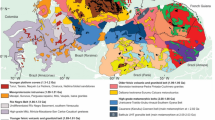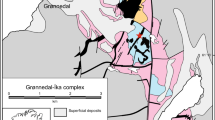Abstract
The most CO2-rich cordierite thus far encountered in nature with about 2.2 wt.% CO2 and 0.3 wt.% H2O occurs as large poikiloblasts in a strange non-foliated “reaction rock” that dissects well-foliated granulites being part of the classical Lapland granulite area described by Eskola. The cordierite is optically positive with the highest optic angle 2V x (∼106°) and birefringence (γ−α = 0.017) ever measured on natural cordierites, but it is also optically very heterogeneous due to secondary loss of CO2 along fractures and zones paralleling the fluid-bearing channels. Based on the optical properties of the degassed Lapland cordierite and on literature data a ternary diagram is given, which shows the variations of this cordierite in 2V x and birefringence as a function of channel-filling with both CO2 and H2O.
Following Losert (1971) the cordierite coexists with calcite, a thus far unique mineral assemblage that is probably only stable at very high CO2 pressures. In the present case, the \(X_{{\text{CO}}_{\text{2}} } \) of the cordierite (∼0.75) indicates, on the basis of literature data, a coexisting fluid with \(X_{{\text{CO}}_{\text{2}} } \)>0.95.
The carbon isotope composition δ 13C of CO2 in cordierite lies near −7‰, that of the calcite is slightly lighter than about −9‰. Thus, at least for the CO2 in cordierite, a deep-seated origin may be possible.
Based on the geologic occurrence it is speculated that the cordierite-bearing “reaction rock” could perhaps represent an annealed channel of late degassing in the granulitic lower crust.
Similar content being viewed by others
References
Armbruster Th, Bloss FD (1980) Channel CO2 in cordierites. Nature 286:140–141
Armbruster Th, Bloss FD (1981) Mg-cordierite: Si/Al ordering, optical properties, and distortion. Contrib Mineral Petrol 77:332–336
Armbruster Th, Bloss FD (1982) Orientation and effects of channel H2O and CO2 in cordierites. Am Mineral 67:284–291
Bloss FD (1981) The spindle stage: principles and practice. Cambridge University Press, Cambridge, 340 pp
Bloss FD, Armbruster Th (1982) Gladstone-Dale constants for channel H2O and CO2 in cordierite. Can Mineral 20:55–58
Bloss FD, Riess D (1973) Computer determination of 2V and indicatrix orientation from extinction data. Am Mineral 58:1052–1061
Carson DG, Rossman GR, Vaughan RW (1982) Orientation and motion of water molecules in cordierite: A proton nuclear magnetic resonance study. Phys Chem Minerals 8:14–19
Conant LC (1935) Optically positive cordierite from New Hampshire. Am Mineral 20:310–311
Eskola P (1952) On the granulites of Lapland. Am J Sci Bowen Volume, Pt 1:133–171
Farrel F, Newnham RE (1967) Electronic and vibrational absorption spectra in cordierite. Am Mineral 52:380–388
Goldman DS, Rossman GR, Dollase WA (1977) Channel constituents in cordierite. Am Mineral 62:1144–1157
Graziani G, Guidi G (1978) Hydrous gem magnesian cordierite with inclusions of hydroxyapaptite, dolomite and rutile. Mineral Mag 42:481–485
Heald HT (1950) Structure and petrology of the Lovewell mountain quadrangle, New Hampshire. Bull Geol Soc Am 61:43–89
Hoefs J (1973) Ein Beitrag zur Isotopengeochemie des Kohlenstoffs in magmatischen Gesteinen. Contrib Mineral Petrol 41:277–300
Hoefs J, Touret J (1975) Fluid inclusions and carbon isotope study from Bamble granulites (South Norway). Contrib Mineral Petrol 52:165–174
Hoefs J, Coolen JJM, Touret J (1981) The sulfur and carbon isotope composition of scapolite-rich granulites from Southern Tanzania. Contrib Mineral Petrol 78:332–336
Hörmann PK, Raith M, Raase P, Ackermand D, Seifert F (1980) The granulite complex of Finnish Lapland: petrology and metamorphic condition in the Ivaljoki-Inarijärvi area. Geol Surv Finl Bull 308:1–95
Johannes W, Schreyer W (1981) Experimental introduction of CO2 and H2O into Mg-cordierite. Am J Sci 281:299–317
Langer K, Schreyer W (1969) Infrared and powder X-ray diffraction studies on the polymorphism of cordierite Mg2(Al4Si5O18). Am Mineral 54:1442–1459
Larsen ES, Berman H (1934) The microscopic deformation of the non-opaque minerals. US Geol Surv Bull 848:266 pp
Lepezin GG, Kuznetsova IK, Lavrenten'ev YuG, Chmel'nicova OS (1976) Optical methods of determination of the water contents in cordierites. Contrib Mineral Petrol 58:319–329
Losert J (1971) Postgranulitic cordierite+calcite+pyrite formation in some granulite rocks of the Norwegian Lapland. Krystalinikum 8:77–107
Mandarino JA (1976) The Gladstone-Dale relationship — Part I: Derivation of new constants. Can Mineral 14:498–502
Medenbach O, Maresch WV, Mirwald PW, Schreyer W (1980) Variation of refractive index in synthetic Mg-cordierite with H2O. Am Mineral 65:367–373
Newton RC, Smith JV, Windley BF (1980) Carbonic metamorphism, granulites and crustal growth. Nature 288:45–50
Newton RC, Wood BJ (1979) Thermodynamics of water in cordierite and some petrologic consequences of cordierite as a hydrous phase. Contrib Mineral Petrol 68:391–405
Pehrmann G (1932) Ueber optisch positiven Cordierit. Acta Acad Abo Ser B 6:12
Selkregg K, Bloss FD (1980) Cordierites: compositional controls of Δ, cell parameters, and optical properties. Am Mineral 65:522–533
Stout JH (1975) Apparent effects of molecular water on the lattice geometry of cordierite. Am Mineral 60:229–234
Suknev VS, Kitzul VI, Lazebnik YuD, Brovkin AA (1971) On presence and quantitative evaluation of CO2 in cordierites in the light of infrared spectroscopic data and chemical analyses, (in russ.) Akad Nauk SSSR Doklady 200:950–952
Touret J (1974) Faciès granulitique et fluides carboniques. In: Michot P (ed) Geologie des domaines cristallins. Ann Soc Belg (Vol Spec), pp 267–287
Touret J (1981) Fluid inclusions in high-grade metamorphic rocks. In: Hollister LS and Crawford ML (eds) Short course in fluid inclusions: application to petrology. Miner Assoc Canada, pp 182–208
Wallace JH, Wenk HR (1980) Structure variation in low cordierites. Am Mineral 65:96–111
Zimmermann JL (1972) Application pétrogénétique de l'étude de la libération de l'eau et du gaz carbonique des cordierites. CR Acad Sci Paris 275D: 519–522
Zimmermann JL (1981) La Libération de l'eau, du gaz carbonique et des hydrocarbures des cordierites. Cinétiques des mécanismes. Détermination des sites. Intérêt pétrogénétique. Bull Mineral 104:325–338
Author information
Authors and Affiliations
Rights and permissions
About this article
Cite this article
Armbruster, T., Schreyer, W. & Hoefs, J. Very high CO2 cordierite from Norwegian Lapland: Mineralogy, petrology, and carbon isotopes. Contr. Mineral. and Petrol. 81, 262–267 (1982). https://doi.org/10.1007/BF00371680
Received:
Accepted:
Issue Date:
DOI: https://doi.org/10.1007/BF00371680




